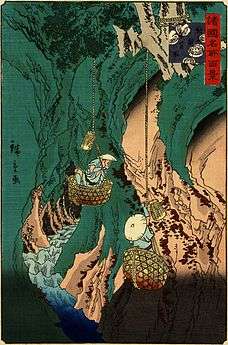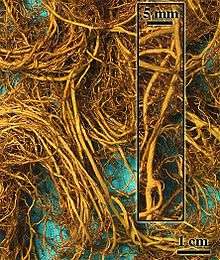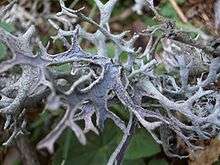Ethnolichenology
Ethnolichenology is the study of the relationship between lichens and people. Lichens have and are being used for many different purposes by human cultures across the world. The most common human use of lichens is for dye, but they have also been used for medicine, food and other purposes.

Lichens for dye
Lichens are a common source of natural dyes. The lichen dye is usually extracted by either boiling water or ammonia fermentation. Although usually called ammonia fermentation, this method is not actually a fermentation and involves letting the lichen steep in ammonia (traditionally urine) for at least two to three weeks.
In North America the most significant lichen dye is Letharia vulpina. Indigenous people through most of this lichen's range in North America traditionally make a yellow dye from this lichen by boiling it in water.
Many of the traditional dyes of the Scottish Highlands were made from lichens including red dyes from the cudbear lichen, Lecanora tartarea,[1] the common orange lichen, Xanthoria parietina, and several species of leafy Parmelia lichens. Brown or yellow lichen dyes (called crottle or crotal), made from Parmelia saxatilis scraped off rocks,[2] and red lichen dyes (called corkir) were used extensively to produce tartans.
Purple dyes from lichens were historically very important throughout Europe from the 15th to 17th centuries. They were generally extracted from Roccella spp. lichens imported from the Canary Islands, Cape Verde Islands, Madagascar, or India. These lichens, and the dye extracted from them, are called orchil (variants archil, orchilla). The same dye was also produced from Ochrolechia spp. lichens in Britain and was called cudbear. Both Roccella spp. and Ochrolechia spp. contain the lichen substance orcin, which converts into the purple dye orcein in the ammonia fermentation process.
Litmus, a water-soluble pH indicator dye mixture, is extracted from Roccella species.
Lichens for medicine
Many lichens have been used medicinally across the world. A lichen's usefulness as a medicine is often related to the lichen secondary compounds that are abundant in most lichen thalli. Different lichens produce a wide variety of these compounds, most of which are unique to lichens and many of which are antibiotic. It has been estimated that 50% of all lichen species have antibiotic properties.[3] Many lichen extracts have been found to be effective in killing Gram-positive bacteria, which included species that cause boils, scarlet fever, and pneumonia [4]
One of the most potent lichen antibiotics is usnic acid, as a result Usnea spp. are commonly used in traditional medicines. Usnea was used in the United States as a fungal remedy of the mouth, stomach, intestines, anus, vagina, nose, ear, and skin, and in Finland it was used to treat wounds, skin eruptions, and athlete's foot.[5] In Russia a preparation of the sodium salt of usnic acid was sold under the name Binan for the treatment of varicose and trophic ulcers, second and third degree burns, and for plastic surgery.[4]
Other lichens commonly featured in folk medicines include Iceland moss and Lungwort.
Lichens for poisons

Only a few lichens are truly poisonous, with species of Letharia and Vulpicida being the primary examples. These lichens are yellow because they have high concentrations of the bright yellow toxin vulpinic acid.
Wolf lichen (Letharia vulpina) was used in Scandinavia to poison wolves. The process begins by adding the lichens to various baits such as reindeer blood and other meats, while sometimes mixing the concoction with ground glass or strychnine. Wolves that ate the concoction were reported to succumb in less than 24 hours. The Achomawi people of northern California use Letharia to poison arrowheads. The arrowheads would be soaked in the lichens for a year sometimes with the addition of rattlesnake venom. Although toxic, wolf lichens were used to treat sores and inflammation by indigenous people in north California and southern British Columbia, and even taken internally as medicine.
Lichens for food

There are records of lichens being used as food by many different human cultures across the world. Lichens are eaten by people in North America, Europe, Asia, and Africa, and perhaps elsewhere. Often lichens are merely famine foods eaten in times of dire needs, but in some cultures lichens are a staple food or even a delicacy. Two problems often encountered with eating lichens is that they usually contain mildly toxic secondary compounds, and that lichen polysaccharides are generally indigestible to humans. Many human cultures have discovered preparation techniques to overcome these problems. Lichens are often thoroughly washed, boiled, or soaked in ash water to help remove secondary compounds.
In the past Iceland moss (Cetraria islandica) was an important human food in northern Europe and Scandinavia, and was cooked in many different ways, such as bread, porridge, pudding, soup, or salad. Wila (Bryoria fremontii) was an important food in parts of North America, where it was usually pitcooked. It is even featured in a Secwepemc story. Reindeer lichen (Cladina spp.) is a staple food of reindeer and caribou in the Arctic. Northern peoples in North America and Siberia traditionally eat the partially digested lichen after they remove it from the rumen of caribou that have been killed. It is often called 'stomach icecream'. Rock tripe (Umbilicaria spp. and Lasalia spp.) is a lichen that has frequently been used as an emergency food in North America. One species of Umbilicaria, Iwa-take (U. esculenta), is used in a variety of traditional Korean and Japanese foods. It is quite expensive, and is collected off the sides of cliffs. In India, and other centers of curry powder production, garam masala sauce contains certain lichens used as bulking agents.
Very few lichens are poisonous. Poisonous lichens include those high in vulpinic acid[6] or usnic acid.[6] Most (but not all) lichens that contain vulpinic acid are yellow, so any yellow lichen should be considered to be potentially poisonous.
Lichens for embalming

Embalming began in Ancient Egypt around 5,000 years ago. The use of lichens in embalming dates to the 18th Dynasty, where Pseudevernia furfuracea was found in an Egyptian vase.[7] The process began with a slit in the abdomen; the organs and viscera were removed. The organs and viscera were wrapped in separate linen packets and replaced in the body or put in canopic jars between the legs. The body cavity was then packed with lichen, sawdust, bruised myrrh, cassia, and other spices.[7] Pseudevernia furfuracea was employed due to its preservative and aromatic qualities. Also it was used simply as a highly absorbent, light-weight packaging material. It also contains antibiotic substances. These qualities helped inhibit bacterial decay of the mummies.[4][8] Another discovery is that the Egyptians would grind and mix Pseudevernia furfuracea with their flour for bread. The bread was then placed with the mummy and thought to be the first meal for the mummy in its afterlife. Pseudevernia furfuracea was imported shiploads from the Grecian archipelago to Alexandria.[4] Today, embalming fluids are colored from the lichen dye orchil into a product called Cudbear, illustrating how a historical procedure can influence future practices.
Other human uses of lichens
Lichens have been and are still being used for many other purposes, including
- Alcohol production (for fermentable carbohydrates, as catalysts, and/or as flavour/preservatives)
- Cosmetics (for hair, and/or sweet smelling powders)
- Perfumes (see Oakmoss)
- Decorations (including costumes and artwork)
- Fibre (clothing, housing, cooking, sanitation)
- Animal feed (both fodder and forage)
- Fuel
- Industrial purposes (production of acid, antibiotic, carbohydrate, litmus)
- Tanning
- Hunting/fishing (to find prey, or to lure them in)
- Navigation
- Insect repellent/insecticide
- Preservatives (for food or beer)
- Poison (arrowheads, wolves: see Letharia vulpina)
- Mummies (see Pseudevernia furfuracea)
- Rituals
- Tobacco
- Narcotics
- Hallucinogens (see Dictyonema)
See also
References
- Brewster, Sir David (1832). Lichen. The Edinburgh Encyclopaedia. Retrieved 10 May 2014.
- "Crottle". Dictionary of the Scots Language. Archived from the original on 12 May 2014. Retrieved 10 May 2014.
- Sharnoff, Sylvia. "Lichens and People". Archived from the original on 20 May 2016. Retrieved 11 January 2015.
- Richardson, D. H. S. 1974. Vanishing Lichens. Their History, Biology and Importance. 231 pp. HafnerPress, New York.
- Vartia, K.O. 1973. Antibiotics in lichens. pp. 547-561. In Ahmadjian, V, Hale, ME, eds. The Lichens. p. 548.
- Emmerich, R., I. Giez, O. L. Lange, and P. Proksch. 1993. Toxicity and antifeedant activity of lichen compounds against the polyphagous herbivorous insect Spodoptera littoralis. Phytochemistry 33(6): 1389-1394.
- Llano, G.A.P. 1944. Lichens: their biological and economic significance. The Botanical Review 10 (1): 1-65. Page 37.
- Baumann, B.B. 1960. The botanical aspects of ancient Egyptian embalming and burial. Econ. Bot. 14(1):84-104. Page 88.
